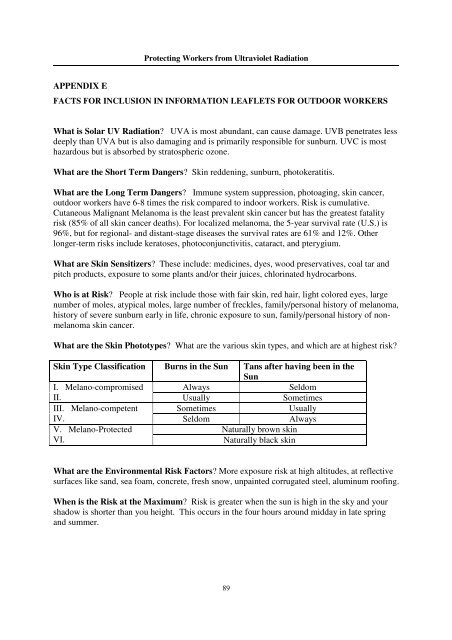Protecting Workers from Ultraviolet Radiation - icnirp
Protecting Workers from Ultraviolet Radiation - icnirp
Protecting Workers from Ultraviolet Radiation - icnirp
You also want an ePaper? Increase the reach of your titles
YUMPU automatically turns print PDFs into web optimized ePapers that Google loves.
APPENDIX E<br />
<strong>Protecting</strong> <strong>Workers</strong> <strong>from</strong> <strong>Ultraviolet</strong> <strong>Radiation</strong><br />
FACTS FOR INCLUSION IN INFORMATION LEAFLETS FOR OUTDOOR WORKERS<br />
What is Solar UV <strong>Radiation</strong>? UVA is most abundant, can cause damage. UVB penetrates less<br />
deeply than UVA but is also damaging and is primarily responsible for sunburn. UVC is most<br />
hazardous but is absorbed by stratospheric ozone.<br />
What are the Short Term Dangers? Skin reddening, sunburn, photokeratitis.<br />
What are the Long Term Dangers? Immune system suppression, photoaging, skin cancer,<br />
outdoor workers have 6-8 times the risk compared to indoor workers. Risk is cumulative.<br />
Cutaneous Malignant Melanoma is the least prevalent skin cancer but has the greatest fatality<br />
risk (85% of all skin cancer deaths). For localized melanoma, the 5-year survival rate (U.S.) is<br />
96%, but for regional- and distant-stage diseases the survival rates are 61% and 12%. Other<br />
longer-term risks include keratoses, photoconjunctivitis, cataract, and pterygium.<br />
What are Skin Sensitizers? These include: medicines, dyes, wood preservatives, coal tar and<br />
pitch products, exposure to some plants and/or their juices, chlorinated hydrocarbons.<br />
Who is at Risk? People at risk include those with fair skin, red hair, light colored eyes, large<br />
number of moles, atypical moles, large number of freckles, family/personal history of melanoma,<br />
history of severe sunburn early in life, chronic exposure to sun, family/personal history of nonmelanoma<br />
skin cancer.<br />
What are the Skin Phototypes? What are the various skin types, and which are at highest risk?<br />
Skin Type Classification Burns in the Sun Tans after having been in the<br />
Sun<br />
I. Melano-compromised Always Seldom<br />
II. Usually Sometimes<br />
III. Melano-competent Sometimes Usually<br />
IV. Seldom Always<br />
V. Melano-Protected<br />
Naturally brown skin<br />
VI. Naturally black skin<br />
What are the Environmental Risk Factors? More exposure risk at high altitudes, at reflective<br />
surfaces like sand, sea foam, concrete, fresh snow, unpainted corrugated steel, aluminum roofing.<br />
When is the Risk at the Maximum? Risk is greater when the sun is high in the sky and your<br />
shadow is shorter than you height. This occurs in the four hours around midday in late spring<br />
and summer.<br />
89



